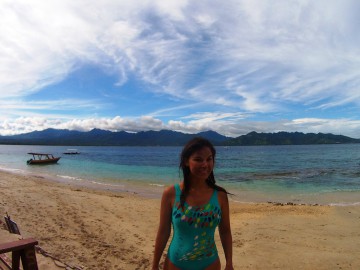
After many attempts painting in the water, I finally found a way to make my dream to paint into the sea come true. First, I managed to stabilize myself in the sea using an 8kg weighted belt. I also bought a small easel, on which I attached 10 kg weights, plus some tiles. Despite all this lead, I still had trouble getting buoyant in the water: each time a boat passed, everything would turn upside down, including myself!
Technical aspect of painting underwater
The hardest part was to create a suitable underwater paint. For me it was crucial to find an environmentally friendly product. I love bright colors, and I needed to find a thick paint which is not toxic to the environment. After much research I was able to create a mixture of natural pigments and linseed oil on an oil painting base. I also found out that using a small trowel rather than a paintbrush was a better way to spread the painting on the canvas.


Also, after many attempts, I realized that the canvas had to be prepared with a special coating so that the paint would adhere better. I let it dry well, then I had the idea to quadrille it with waterproof tape to give a structure to the painting.


Once everything was set, I dived! I looked for a quiet place in the sea. My first satisfactory experience was on Gili Air Island, which is close to Bali. This island has a beautiful emerald green sea, with a white sand beach, which is good to take pictures of me performing this art. It is essential to have a sea without waves, transparent and shallow. I dived about 1.5 meters (4.9 feet) deep, and still today this is how I work. I have also already painted at 4 meters (13.1 feet) deep with diving equipment in the sea close to Lombok.


To paint underwater with scuba diving equipment was a fantastic experience, and I learned a lot about colours while painting at a 4m depth. Actually, I noted that the deeper down I painted, the less the painting would stick on the canvas. Also, the colors are not perceived the same way according to the depth: the deeper you go, the less red appears. One day while scuba diving, I painted my canvas completely brown to represent the coral. When I came back to the surface, I found out that the painting was actually red!


When the painting is dry I add recycled nail polish
After each underwater painting session, I have to arrange the paintings a little bit. Indeed, they appear to me in a different way underwater, and I want to make them as similar as possible to this stage. Under the sea, the colours are more shiny and glittery. For this reason, I follow a specific process: when I finish my painting, I go back to the surface whether on a boat or on the beach. I gently remove the strips of tape, and then I let the fabric canvas dry in the sun for several hours.When the paint is dry, I add some details like glitter or nail polish. These products are the one I use to make my artwork, and I like the shiny effect, which makes it look magical!


After I finish painting underwater, I remove the stripes of tape, let the fabric dry for a few hours and add some extra details with nail polish and glitter.
Usually I get out of a working session covered with paint stains from head to toe! My bikini is also frequently stained with paint, but this is my work coat and I often have to change it. I clean my equipment with soap because, as I use natural paint, I do not need toxic products such as turpentine to remove traces of paint.


After an underwater painting session I am generally covered with painting from head to toes.




